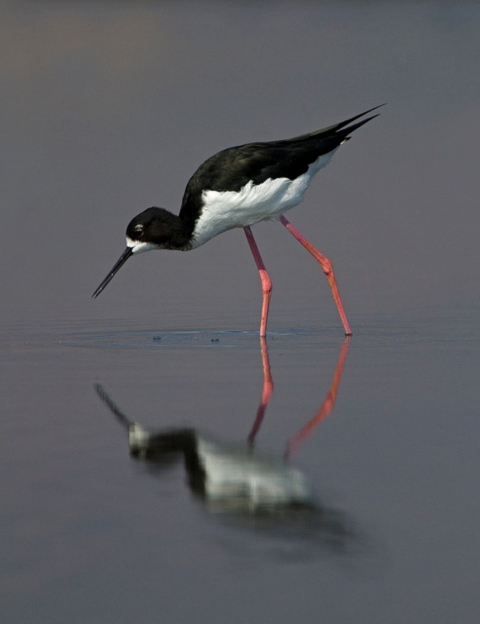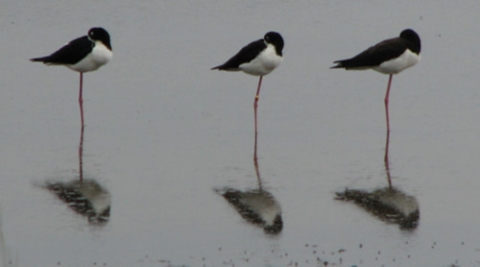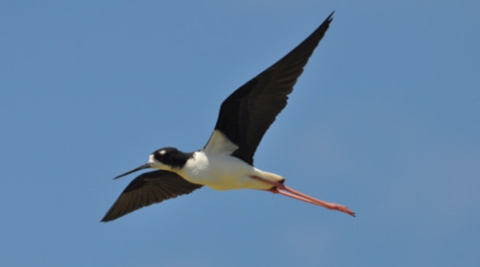Scientific Name: Himantopus mexicanus knudseni
Hawaiian Name: Ae’o
Common Name: Hawaiian Stilt
Status: Endangered
Black winged birds with white bellies soar overhead, their long pink legs seeming to trail behind them. When they land in shallow water, it’s easy to imagine their small bodies balancing upon a pair of stilts. The Hawaiian stilt, or ae’o, makes its presence known not only in stature, but in sound as well. Constantly vocalizing–whether warning, attracting mates, or chatting–ae’o can be easily spotted at many of Hawai’i’s protected wetlands.
However, hunting took its toll on these native waterbirds. As populations started to decline and wetland habitats degraded, the ae’o was listed as Endangered. Now, since hunting was prohibited in the 1940’s and conservation actions were taken by many state, federal, and non-profit organizations, the ae’o can still chatter endlessly all over the state of Hawai’i.
Habitat and Range
The ae’o can be found on all of the main Hawaiian islands except Kaho’olawe, foraging and nesting in wetland habitats. However, ae’o prefer two different areas for feeding and breeding. They forage in shallow water less than 9 inches deep with little, low-growing vegetation; and they nest next to or on low islands with standing fresh, brackish, or salt water habitats, or open tidal flats. Ae’o travel between their two habitats daily, defend their nesting sites aggressively, and stay in open mudflats or open flooded pastures where predator numbers are low and visibility is high.
Diet and Life Cycle
Ae’o is opportunistic, feeding on different aquatic organisms like worms, small crabs and fish, and insects.
They typically nest from January through July, laying between 3-4 eggs. Nests are either a pile of sticks or small indentations in the ground. About 24 days later, the chicks hatch and are precocial: they can leave the nest soon after. Both parents raise their chicks for several months, and by August chicks are done fledging. The lifespan of ae’o is unknown.
Threats to the Species
Habitat loss remains a threat to the ae’o, as wetlands are being filled, dredged, contaminated by oil spills, or altered for agricultural and other reasons (see the ‘alae ‘ula blog for more threats). Introduced predators also pose a problem for habitat maintenance and predate upon ae’o. These include: feral dogs and cats, mongooses, rats, Cattle Egrets, bullfrogs, Barn Owls, and ‘auku‘u (black-crowned night herons). Invasive plants species also reduce water levels and necessary habitats for ae’o, like water hyacinth, mangrove, and pickleweed. Avian diseases like botulism also pose a concern.
Reason for Hope
Since the ae’o has been on the Endangered Species List, its population numbers have increased across the state, thanks to inter-agency and organization collaboration on research and protection. These conservation actions include restoring wetland habitats, banning hunting, monitoring, and predator control.
Where You Can See Them
James Campbell NWR
Pearl Harbor NWR
Hanalei NWR
Hulēʻia NWR
Kakahai’a NWR
Keālia Pond NWR
Article by Elena Fischer, External Affairs Kupu AmeriCorps Intern with the U.S. Fish and Wildlife Service
###
The U.S. Fish and Wildlife Service works with others to conserve, protect, and enhance fish, wildlife, plants, and their habitats for the continuing benefit of the American people. For more information, visit www.fws.gov/pacificislands, or connect with us through any of these social media channels at https://www.facebook.com/PacificIslandsFWS, www.flickr.com/photos/usfwspacific/, https://medium.com/usfwspacificislands or www.twitter.com/USFWSPacific






